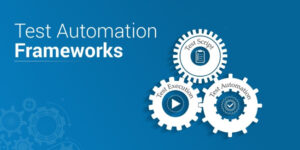
Automation Testing is one of the most trending components of the modern application test bench. This is because, with the help of its superficial features, the developers can easily accomplish all the complex testing requirements. All current applications have become a one-stop solution where the core framework of the application needs to access multiple elements at the same time to function correctly. To uphold such a structure, the developers have to ensure the proper individual functions of all the components and their integrated functioning.
The developers can easily accomplish these goals with the help of various automation testing practices like Selenium Testing. The developers can also incorporate additional tools, plugins, and libraries to improve the efficiency of the test cases.
With the help of this article, we will take a detailed look into all the steps the developers have to follow to migrate their test cases to Selenium. We will also discuss some of the most interactive Selenium-based platforms and tools that can help developers during this process.
Understanding Test Automation
We can easily understand the core definition of test automation by understanding the name. In simple terms, we can explain test automation as the process of automatically starting and executing test cases without the involvement of human developers and testers. For this purpose, the system will choose a test file that will consist of all the necessary parameters required for the completion of automation testing. This test file will also consist of multiple test data that will be useful for analyzing the user interaction capabilities of a modern web application.
It is worth mentioning that while using automation testing, the testers can also change the data to make it suitable for their testing requirements. Automation test cases are also reusable. This means that developers can reuse the test cases in future projects.
However, while we are on the topic of test automation, we must mention that the significant disadvantage of this advanced process is that it comes with an expensive setup process. This is because, during the initial stages of automation testing, the developers have to integrate different libraries and software for the smooth execution of automation testing.
Moreover, test automation comes with a steep learning curve where the developers must get accustomed to all the modern automation testing practices. So app development companies need to analyze their possible business perspectives and returns on investment before beginning the transition.
Developing a Basic Idea of Selenium
As mentioned earlier, Selenium is a test suite that helps developers initiate automation test cases on web applications. It is essential to note that Selenium had a monopoly in the automation testing market during the early stages of test automation. However, various new competitors like Playwright and Cypress have recently arrived in the market. However, with the help of its interactive features and constant updates, Selenium has still managed to maintain one of the top positions in the market.
A fascinating fact about Selenium is that during the initial years, it was known as the JavaScriptTestRunner because it was based on this reputed programming language. Selenium supports almost all the well-known programming languages so that the developers can create test cases in their preferred language.
However, the significant advantages of Selenium cannot overshadow the massive drawback that comes with this automation test suite. This is because while using Selenium, the developers can only initiate automation test cases on web applications. There are hundreds of different types of applications, like native apps, web apps, and hybrid apps, that are readily available in the market. So this limitation can massively hamper the development abilities of a modern web company.
Moreover, a common misconception about Selenium is that it is a standalone tool. However, the reality is that it is a test suite consisting of multiple tools. All of these tools have a specific role in the application development process. The explanation of all the Selenium component tools is as follows:
- Selenium WebDriver: Interestingly, it is often considered a crucial component in the Selenium test suite because it not only helps the developers to start the automation testing processes but also helps them to redirect them to the appropriate target elements. After the Selenium 4 update, the Selenium WebDriver has become even more useful and simple for new developers. The Selenium WebDriver is also a superior version of the deprecated remote controller. This is because the Selenium WebDriver can natively communicate with all the elements of a web application.
- Selenium Grid: With the help of the Selenium Grid, the developers can conduct all the Selenium-based automation testing processes in a parallel testing format. We can define parallel testing as conducting multiple different test configurations simultaneously. This is a critical process when developers work on complex apps with thousands of other elements. Experts believe that with the help of the Selenium Grid, the developers can improve the efficiency of the Selenium Grid by several times.
- Selenium IDE: The term IDE signifies an integrated development environment. With the help of Selenium IDE, the developers can efficiently create automated test cases for initiating the testing process. This is a unique process as Selenium helps developers to create test cases by only accessing the application like a regular user. This is because while the testers are using the application, the intelligent framework will automatically continue to generate the test cases based on the interactions.
RELATED POSTS:
- How Does Machine Learning Implementation Simplify the Software Testing Process?
- 30 Automation Testing Interview Questions With Answers
Steps to Migrate to Selenium for Automation Testing of Web Apps
The developers have to follow the simple steps given below for migrating the automation testing processes of web applications to Selenium:
1. The first step in this process is to perform pre-migration testing on the test cases. In this process, the developers have to verify the stable performance of the web applications before the migration process.
2. After this, the developers have to perform the testing process during the migration. In this phase, the system will verify the stable performance of the web application as it begins the transition to Selenium.
3. After the previous two stages, the developers have to complete post-migration testing. In this test, the system will finally verify the stable performance of the web application after the migration process has been completed.
4. During this process, the developers must copy the source code from the previous automation testing framework and paste it into the Selenium native testbench.
5. The developers could also create a new project in Selenium to store all the relevant test cases with the appropriate target name.
6. The final step in this process is to write the first Test case with Selenium and execute it on the Selenium terminal window. Selenium also helps the developers to maintain an activity log to ensure a smooth debugging process that will follow soon after.
Also See: Automation Testing and Manual Testing Which is the Best?
Role of Tools and Platforms in Selenium Testing
As discussed earlier, tools and platforms can massively help developers simplify the application development and testing process while working with automation testing. On simple analysis, the developers will realize that hundreds of tools are readily available in the present market. However, developers and testers must choose the perfect tool or platform to complement their testing practices. Moreover, specific platforms integrate additional features to improve the efficiency of the testing process. For instance, a category of platforms known as cloud-based platforms helps developers eliminate the need to have an in-house physical test bench. This is because, with these platforms, the developers can execute testing on real devices over the web.
With cloud platforms, developers can eliminate all geolocation barriers in the application testing process. This means they can initiate and execute the testing processes from anywhere globally. We can learn and understand more about the importance of cloud-based platforms by shifting our focus toward LambdaTest as a reference:
To finish the introductory process, we can define LambdaTest as a platform to initiate and execute secure cross-browser testing processes on modern web apps. Considering the standards of the modern development environment, we can safely say that cross-browser testing has become the new standard for ensuring the highest quality of applications. This is because, with cross-browser compatibility test cases, the developers can ensure that the application performs flawlessly, irrespective of device hardware, operating system, or browser version changes. This also has various important features to help the developers improve the efficiency of the testing process. With LambdaTest, the testers can import the automation test cases from Selenium and other popular frameworks like Cypress and Playwright.
In this context, it is worth mentioning that while working with Selenium-based automation test cases, the developers can verify their functioning on more than 3000 unique browsers. LambdaTest also supports the verification of internal web apps that are locally hosted. The integration of real devices with existing emulators and simulators massively improves the accuracy of the test cases.
Related Post: How to Implement a Functioning Test Automation Program
Final Verdict
Considering all the factors, we can justify that Selenium testing is one of the most important components of the modern app development industry. Modern automation developers and testers need to get themselves accustomed to all the latest trends and innovations in this segment. The app development companies can also hold seminars and awareness campaigns to spread all the relevant information regarding these testing practices.
The app developers and testers should also have adequate knowledge about the requirements of their target audience. This will help them to customize the application according to their needs. Lastly, it is crucial to understand the importance of a proper tool or platform in the success of an automation test bench.






